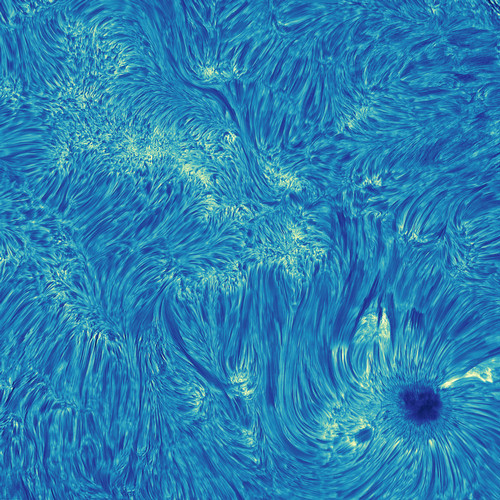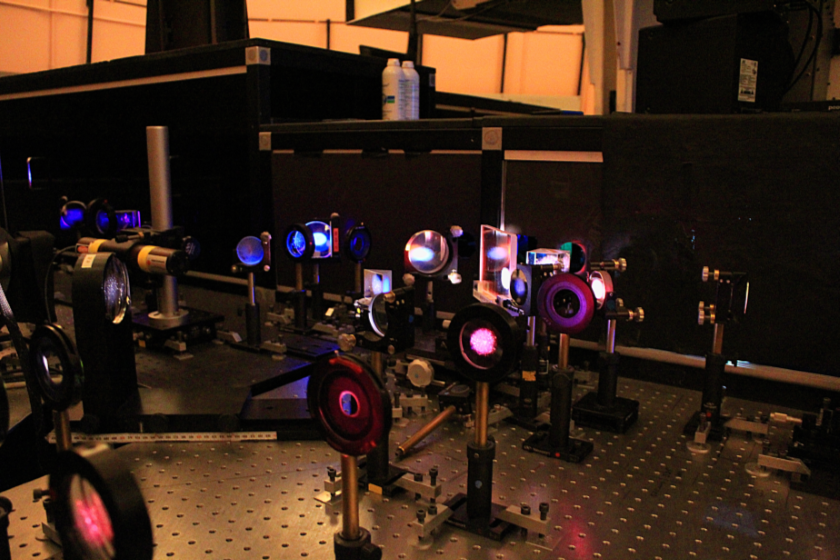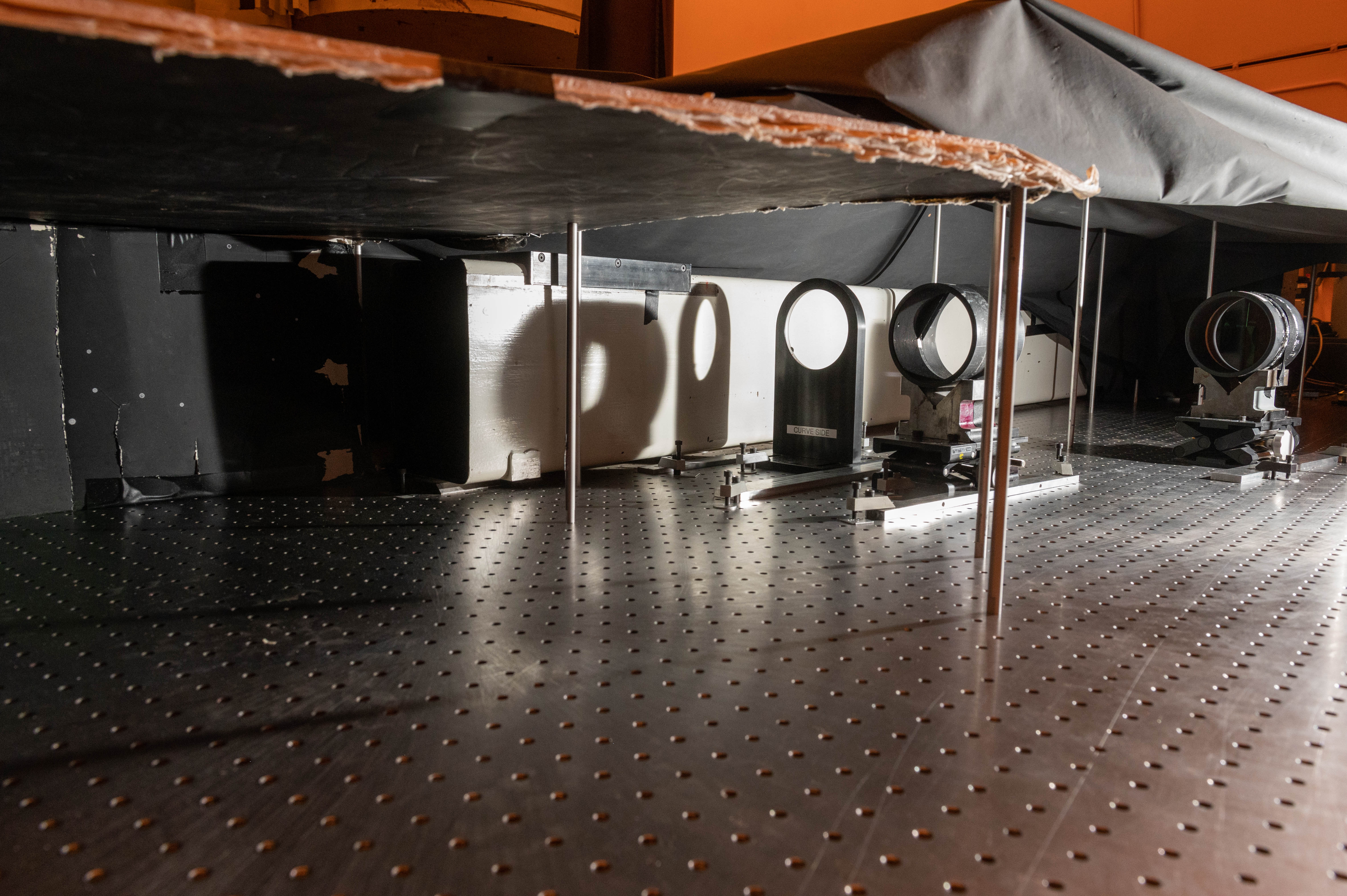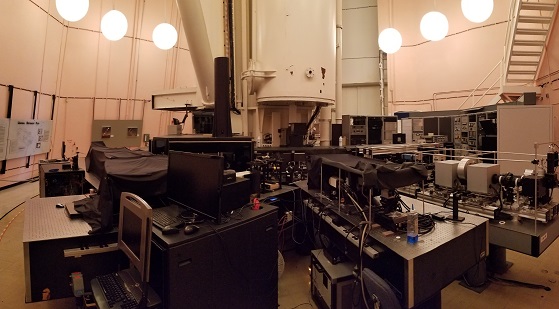Instruments
Research & Instruments
Dunn Solar Telescope's open optical bench system makes it easy for solar astronomers to collaborate with DST on scientific research.

The Dunn Solar Telescope, or DST as it is also known, was inaugurated as the world's premier high spatial resolution optical solar telescope in 1969. Today, one high-order adaptive optics (AO76) bench produces sub-arc-second imaging (0".14 @ 430 nm) for an array of advanced instruments. Data taken at the Dunn are available to the public at our data site.


Instruments at DST
Here are some instruments that organizations have constructed to be used in collaboration with DST for solar research.
ROSA (ARC, QUEEN'S UNIVERSITY BELFAST)
The Rapid Oscillations in the Solar Atmosphere instrument is a high-cadence, high-efficiency solar imaging instrument. Designed by the Astrophysics Research Center at Queen's University Belfast in Northern Ireland, ROSA consists of six cameras, each sensitive to a different wavelength band. ROSA is capable of a cadence greater than 30 fps, and is capable of extremely high resolution, corresponding to a spatial scale ranging from 52-98 miles (84-158 km) in the solar atmosphere.
More ROSA information and publications
FIRS (IFA, UNIVERSITY OF HAWAI'I)
The Facility InfraRed Spectropolarimeter is an advanced slit-based spectropolarimeter designed to provide simultaneous coverage of visible and infrared wavelengths. It was designed by the Institute for Astronomy at the University of Hawai'i, with support from the National Solar Observatory (NSO). It is designed to maximize efficiency when observing the spectral lines of Helium and Iron. By positioning the spectrograph slit in multiple locations along a region of interest, FIRS can be used to build a map of the region at a high spatial and spectral resolution.
More FIRS information and publications
SPINOR (HAO & NSO)
The Spectro-Polarimeter for INfrared and Optical Regions is a slit-based spectropolarimeter built by the High Altitude Observatory (HAO) in Boulder, CO, and the NSO. Up to four synchronized cameras sample different spectral lines, with up to two infrared channels, providing spectropolarimetry for much of the visible and near-infrared regime.
Research at DST
Here are some published research articles that reference their collaborative efforts with DST.
SELECTED PUBLICATIONS, ROSA:
1. Jess, D.B., Mathioudakis, M., Christian, D.J., Keenan, F.P., Ryans, R.S.I., Crockett, P.J., 2009,
Solar Physics, 10, 1007,
ROSA: A high cadence, synchronized, multi-camera solar imaging system
2. Jess, D.B., Mathioudakis, M., Christian, Crockett, P.J., Keenan, F.P., 2010,
The Astrophysical Journal Letters, 719, L134-L139,
A Study of Magnetic Bright Points in the NaI D1 Line
3. Crockett, P.J., Mathioudakis, M., Jess, D.B., Shelyag, S., Keenan, F.P., Christian, D.J., 2010
The Astrophysical Journal Letters, 722, L188-L193,
The Area Distribution of Solar Magnetic Bright Points
SELECTED PUBLICATIONS, FIRS:
1. Jaeggli, S.A., Lin, H., 2009
The First Vector Magnetogram Comparison Group Meeting, October 2009, NSO/Tucson
FIRS: A New Instrument for Multi-Wavelength Spectropolarimetry
2. Jaeggli, S.A., Lin, H., Mickey, D. L., Kuhn, J. R., Hegwer, S. L., Rimmele, T. R., Penn, M. J., 2009
NSO Workshop #25, September 2009, Sacramento Peak
FIRS: A New Instrument for Photospheric and Chromospheric Studies the Dunn Solar Telescope
3. Jaeggli, S.A., Lin, H., Uitenbroek, H., 2010
The 6th Solar Polarization Workshop, Ka'anapali, June 2010
Molecule Formation and Magnetic Field Evolution in Sunspots
SELECTED PUBLICATIONS, SPINOR:
1. Socas-Navarro, H., Elmore, D., Pietarila, A., Darnell, A., Lites, B.W., Tomczyk, S., Hegwer, S., 2006
Solar Physics, 235, 55-73
SPINOR: Visible and Infrared Spectro-Polarimetry at the National Solar Observatory
